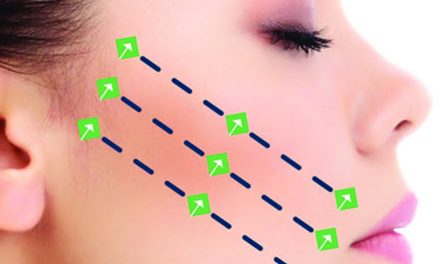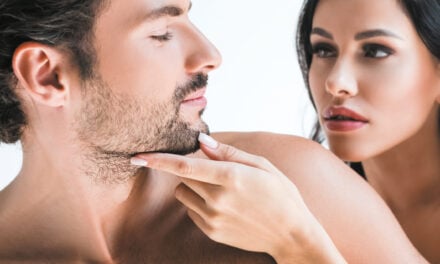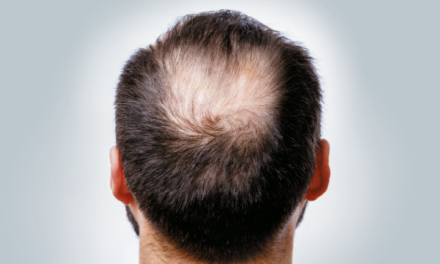Steven Harris discusses his approach to rejuvenating the lips along with facial reshaping for more natural and balanced results
In terms of evolutionary psychology, there are three major facial features we look for in a biological mate: symmetry, averageness, and non-average sexual dimorphism. With regards to the latter, men tend to prefer women with neonatal (neotenous) features which carry evolutionary significance, including large eyes and large, full lips. Indeed, studies involving eye-tracking exercises show that we all tend to fixate on the eyes followed by the mouth (eye-mouth gaze continuum) much more so than any other area of the face1. It is no surprise then that lip procedures involving dermal fillers rank as one of the most popular non-surgical treatments with ever increasing interest, especially on social media. However, the lips are probably the most challenging non-surgical facial procedure to perform as they require an artistic acumen with excellent technical skills in order to produce subtle and beautiful natural looking results.
During the assessment phase, it is essential to consider and treat the face as a whole. No area of the face exists in isolation; treating one area affects the appearance of the others and the lips are no exception. As we age the facial skeleton shrinks towards the midline with an inward rotation. The unsupported soft tissues weigh in on the lips, which collapse due to loss of their own intrinsic and extrinsic support. Treating the lips directly without restoring the surrounding supportive framework will invariably lead to an unnatural and unsatisfactory result. A more balanced and natural aesthetic result can be achieved by restoring the peripheral outline (facial reshaping) and the areas immediately around the mouth, including the teeth, where a malocclusion can affect the shape of the lips. By considering and addressing the surrounding areas, the lips themselves will, to a large extent, be corrected through a process of ‘indirect beautification’ (Figure 1). It is only then that they would be treated directly (‘direct beautification’) for a more natural, balanced and harmonious result.

Figure 1 Facial reshaping with indirect beautification of the lip
Facial reshaping involves deep periosteal injections on the bony outline (forehead, temple, lateral cheek, angle of the jaw and chin) to outwardly rotate the ageing face and restore its ideal shape2. The ideal facial shape for both genders is oval, but there can be considerable variation from a heart shape in women to a more square shape in men. An integral part of facial reshaping is ‘myomodulation’, the change in muscle activity when a filler is placed next to it. It appears that when a filler is injected deep to an elevator or depressor muscle (in the mid or lower face), there is a net elevator effect to lift the tissues from the midline, including the lips. For example, injecting a bolus of filler on the zygomatic bone deep to the zygomaticus major appears to favour its activity and that of all the mid and lower facial elevators over their depressor counterparts with a net lifting effect. The same effect is observed if the filler is placed deep to one of the depressor muscles, such as the depressor anguli oris, inhibiting its activity and all the depressors in favour of the elevators. The net lifting effect helps to restore the ideal facial shape.
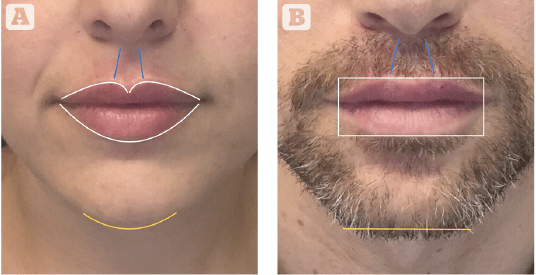
Figure 2 Lower face differences between men and women
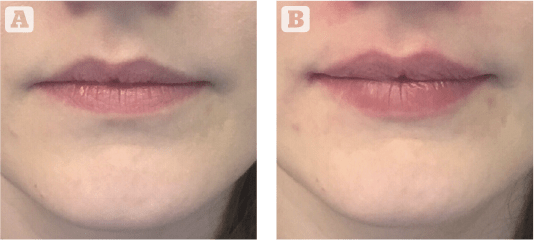
Figure 3 The non-surgical lip lift to restore the popular 1:1 lip ratio
In addition to the effects of myomodulation, injecting the nasolabial folds on the pyriform fossa lifts the upper lip while filler placed more superficially in the labiomental crease has the same lifting effect on the lower lip.
Once the face and surrounding structures have been addressed, the lips should be assessed in terms of their shape and size. The ideal size should be matched to the size of the face and its features, in particular the eyes. Larger lips fit larger eyes but look out of place with smaller size eyes. Lips come in different shapes and there are important differences to consider between men and women. In men, the lips tend to be wider and flatter, often described as rectangular. In women, they are fuller and curvier with a more pronounced Cupid’s bow (Figure 2).
The shape of the lips may be improved in terms of size, definition, symmetry, and proportions. The ideal shape of the lips are well defined, symmetrical (left to right) and well proportioned in relation to the surrounding structures and the face as a whole. Their definition may be enhanced by subtly treating the fine vermillion border, but care should be taken not to over-treat this delicate transitional zone as the filler can escape into the perioral area to create the commonly observed and unsightly ‘duck look’. Symmetry in the face is desirable, but in the lips it is essential and as with all other areas of the face, it is advisable to start treatment on the weaker side (to match the stronger side). The ideal lip ratio top:bottom is often said to be 1:1.618 in line with the ‘golden ratio’, but a recent and comprehensive survey shows a clear preference for a 1:1 ratio3 (Figure 3).
Non-surgical lip lift
The non-surgical lip lift (NLL) is an artistic approach to lip augmentation involving dermal fillers that safely and reliably leads to subtle and beautiful natural looking results. The NLL makes use of the natural anatomy of the lip, in particular its tubercles (Figure 4) to gently and subtly augment them while defining and increasing vertical height from under the vermillion border rather than directly inside the border itself. Only fillers made of hyaluronic acid (HA) should be used as these are relatively safe compared to other fillers and fully reversible with hyaluronidase in case of a complication, or unsatisfactory result. Ideally, the HA filler of choice would be ‘soft’, cohesive, and predictable causing minimal swelling.
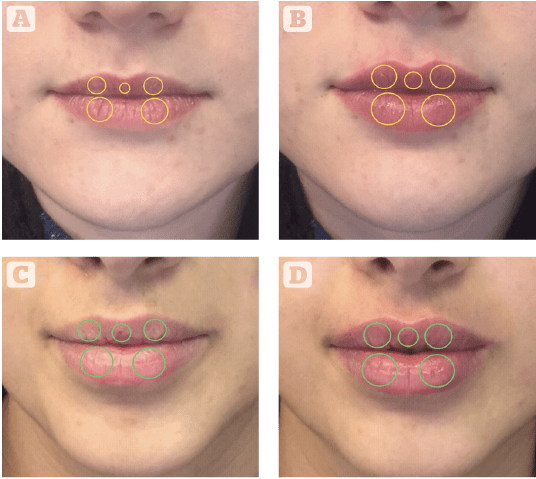
Figure 4 The lips tubercles in two patients (before and after treatment with the NLL).
The NLL involves ten steps, but depending on the lips being treated, there may be a wide variation in the number and order of steps (Figure 5). The typical amount of filler used is between 0.5-1 ml in total and usually between 0.05-0.1 ml per step. All the steps involve slow injections anteriorly and superficially in front of the posteriorly positioned superior and inferior labial arteries. The steps are described in Figure 5, where approximately 0.1ml of filler was used in each. When injecting, the bevel of the needle should face inward to avoid the filler from showing. However, when injecting under the upper vermillion border, the bevel should be facing upward (to help lift the border). The ‘curved thread’ technique (steps 3 and 8) is a variation on the linear thread technique involving a curving motion when injecting to accentuate the upper lip curve. Steps 1, 4, and 5 involve augmenting the tubercles, which can lead to a small and pouty gap that I refer to as the Aesthetic ‘O’.
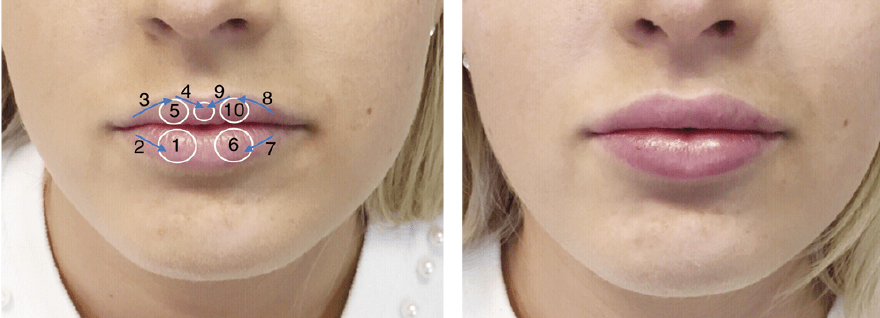
Figure 5 The Nonsurgical Lip Lift (NLL) technique showing the injected tubercles (white circles) and threads of fillers (arrows). The steps: 1. Bolus injection into the right lower tubercle. 2. Linear thread above the vermillion border. 3. Curved thread below the vermillion border. 4. Linear thread along the right side of the Cupid’d bow (starting from the middle tubercle). 5. Bolus injection into the right upper tubercle. 6. Bolus placement in the left lower tubercle. 7. Linear thread above the vermillion border. 8. Curved thread below the vermillion border. 9. Linear thread along the left side of the Cupid’d bow (starting from the middle tubercle). 10. Bolus injection into the left upper tubercle.
Advancement of the NLL technique involves ‘tubercle shifts’ where the lip tubercles are subtly augmented on the desired direction of shift or movement for the patient’s ideal shape. Thus, injecting on the medial aspects augments or ‘shifts’ them toward the midline (narrowing the relevant section of the mouth) whereas placing filler on the lateral aspects shifts them away from the midline (to widen the relevant section). In this way, the tubercles (one or more) may be recruited and shifted in multiple planes and directions (Figure 6).
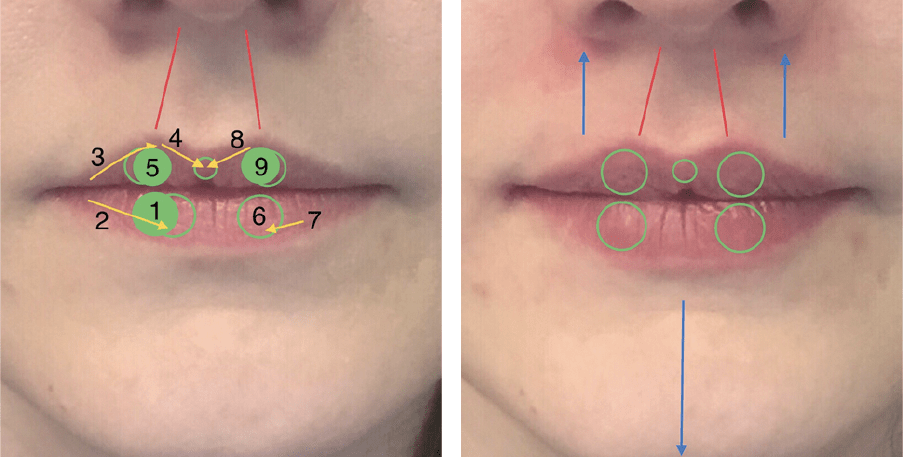
Figure 6 The NLL with tubercle shifts to reduce the width of the mouth
Conclusion
Finally, the NLL is a relatively safe and effective technique that makes use of the natural anatomy of the lips to gently and subtly augment them. It enhances definition, shape, symmetry, and proportions without compromising the vermillion border and therefore projects more on a vertical lifting plane upwards rather than an outward projecting one. The shape of the lips may be altered through ‘tubercle shifts’, which involves augmenting an aspect of the tubercle to ‘shift’ it for the desired outcome. When performed correctly, the NLL leads to consistently subtle and beautiful natural-looking results with a very high patient satisfaction rate.
Declaration of interest None
Figures 1-6 © Dr Harris



